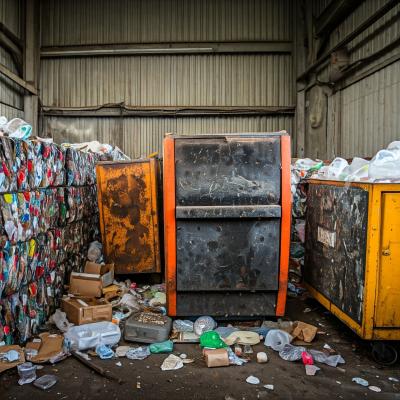As environmental concerns continue to grow, recycling has become a cornerstone of sustainable living. In Utah, the importance of recycling is especially pronounced due to the state’s unique geography and commitment to preserving its natural beauty. Recycling center in Utah play a crucial role in reducing waste, conserving resources, and promoting eco-friendly practices. Here’s everything you need to know about recycling center in Utah, how they operate, and how you can contribute to a greener future.
Why Recycling Matters in Utah
Utah is home to stunning landscapes, from the red rock deserts of Moab to the snow-capped peaks of the Wasatch Range. However, these natural wonders face threats from increasing waste and pollution. Recycling helps mitigate these threats by:
- Reducing Landfill Waste: Recycling diverts materials like plastics, metals, and paper from landfills, conserving valuable space.
- Conserving Natural Resources: It minimizes the need for raw material extraction, protecting Utah’s ecosystems.
- Decreasing Pollution: Proper recycling reduces harmful emissions from incineration and manufacturing.
- Boosting Local Economy: Recycling centers create jobs and support the circular economy in Utah.
How Recycling Centers in Utah Work
Recycling center in Utah operate as collection and processing hubs for recyclable materials. Here’s a breakdown of their typical process:
1. Collection
Recyclable materials are collected from curbside programs, drop-off locations, or directly from businesses.
2. Sorting
Materials are sorted into categories such as plastics, glass, metals, and paper. Advanced machinery and manual labor are often used in this step.
3. Cleaning and Processing
Contaminants like food residues are removed, and materials are prepared for recycling. This may involve shredding, melting, or compacting.
4. Transportation
Processed recyclables are shipped to manufacturers who use them to create new products.
Types of Materials Accepted at Utah Recycling Centers
Different recycling centers in Utah accept varying types of materials. Here’s a general list:
1. Plastics
- Commonly accepted: PET (#1), HDPE (#2), and other recyclable plastics.
- Avoid: Non-recyclable plastics like bags and styrofoam (unless specified).
2. Paper and Cardboard
- Newspapers, magazines, office paper, and cardboard boxes are widely accepted.
3. Glass
- Bottles, jars, and other glass containers can be recycled. Check if your local center accepts glass as not all do.
4. Metals
- Aluminum cans, steel, and scrap metals are accepted at most centers.
5. Electronics
- Some recycling centers handle e-waste, such as old computers, cell phones, and TVs.
6. Hazardous Materials
- Items like batteries, paint, and motor oil are accepted at specialized facilities only.
How to Start Recycling in Utah
Getting started with recycling in Utah is easier than you might think. Follow these steps to make a difference:
1. Understand Local Rules
Each city in Utah may have slightly different recycling guidelines. Check with your local recycling center or municipal website for specifics.
2. Separate Your Waste
Sort recyclables from non-recyclables. Rinse containers to avoid contamination, which can lead to entire batches being discarded.
3. Utilize Curbside Programs
Many Utah cities, such as Salt Lake City and Provo, offer curbside recycling. Ensure you place items in the correct bins.
4. Visit Drop-Off Centers
For materials not accepted curbside (e.g., glass or electronics), find a nearby drop-off location.
Share recycling tips with friends, family, and neighbors to increase participation in your community.
Challenges of Recycling in Utah
While Utah has made strides in recycling, there are challenges to overcome:
1. Contamination
Improper sorting can contaminate recyclable materials, rendering them unusable.
2. Limited Access
Rural areas may have fewer recycling centers, making it harder for residents to participate.
3. Market Fluctuations
The demand for recycled materials can vary, affecting the profitability of recycling programs.
4. Lack of Awareness
Many Utahns are unaware of what can and cannot be recycled, leading to missed opportunities.
Mail in Program
Innovative Recycling Initiatives in Utah
Despite these challenges, Utah is taking innovative steps to boost recycling:
1. Public Awareness Campaigns
Programs like Recycling Simplified educate residents about proper recycling practices.
2. Expansion of Glass Recycling
Momentum Recycling has established glass drop-off points across the state.
3. E-Waste Recycling Events
Cities organize collection events for electronics, ensuring safe disposal.
4. Incentives for Businesses
Utah offers incentives for companies that implement sustainable waste management practices.
Benefits of Recycling for Utah’s Environment
Recycling directly contributes to preserving Utah’s unique landscapes. Key benefits include:
- Protecting Wildlife: Reduced waste minimizes the impact on habitats.
- Saving Water and Energy: Recycling uses less water and energy compared to creating new materials.
- Reducing Carbon Footprint: Diverting waste from landfills decreases methane emissions.
Conclusion: Make a Difference Today
Recycling center in Utah are pivotal to maintaining the state’s natural beauty and promoting sustainability. By participating in recycling programs, you can play a part in protecting the environment and supporting the local economy. Whether you’re a seasoned recycler or just starting, every effort counts. Let’s work together to create a cleaner, greener Utah for future generations.
FAQs
1. What materials are not recyclable in Utah?
Non-recyclable items include styrofoam, plastic bags, greasy pizza boxes, and certain types of glass. Always check with your local center.
2. Are there recycling programs for electronics in Utah?
Yes, many cities and private organizations offer e-waste recycling events and services.
3. How can I recycle hazardous materials like batteries or paint?
Special facilities or collection events handle hazardous materials. Contact your local recycling center for guidance.
4. Is glass recycling available throughout Utah?
Not all areas have glass recycling programs. Check with Momentum Recycling or your local center for options.
5. Can businesses in Utah participate in recycling programs?
Yes, many recycling centers offer commercial recycling services tailored to businesses’ needs.

